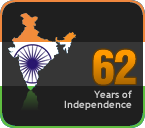For a Mumbaikar like me, all the streets are already occupied – by hawkers, homeless street-dwellers, migrating construction workers, illegal stalls, jobless youth looking for some roadside entertainment, auto rickshaws, cars, buses commuting those fortunate to be employed to their place of work and even by stray dogs that are rapidly growing in numbers everywhere.

In short it is occupied - by all of us!
But the ones who can really be said to be ‘occupying’ the streets in the true sense of the term, are the construction agencies, who are busy building flyovers, metro lines, skywalks and such structures that we would need “for a better tomorrow”, while we are urged “to bear with us today”!
With a clearly drawn out strategy, these agencies coordinate efficiently to plan where to pitch their giant mechanized earth-digging equipment appropriately called ‘bull-dozers’. Squatting in the middle of a busy road isn’t possible without some amount of bull-dozing! But squatting in public places is a common phenomenon – zunka-bhakarstalls, roadside vendors, paan-bidi shops - they all do it with the ‘cooperation’ of the local goons. Thanks to all these occupants, ‘occupying a street’ is close to impossible – not even to protest for the paucity of space to “occupy”!
Why do we even want to get on to already crowded streets to protest, when the national TV channels can do just as well, one may ask? With the phenomenon of squatting having caught up in news channels too, getting their attention is not an easy task either. The spokespersons of all leading parties, political commentators and editors of newspapers and periodicals seem to have a permanent slot allocated to them. The controversies are never allowed to die down – or at least until another one emerges. The need of the hour is to protest about the dearth of space to ‘occupy’, but to gain a foothold in the visual media would be quite an ordeal, for the simple fact that it is already “occupied”! But how can anyone appear there unless one takes to the streets to highlight the predicament we face?
Even the print media is not free from this ‘Over-occupied’ phenomenon considering the dearth of available print space to reach out to the readers. ‘Letters to the editor’, the usual place where a common man rants out his regular grievances is too scant to do justice to the incoming flood of mails. And again – who really reads them? Too many matters to raise and just too little space to do it!
That leaves hardcore protestors wanting to enter the living rooms of millions of television viewers with only one option – to head to the already occupied streets armed with placards, slogans, street-plays and the necessary pluck to break prohibitory orders. That would mean courting arrest aka “Jail Bharo andolan’ , a call to ‘occupy’ prisons. But high profile self-serving public servants and greedy corporate honchos who indulged in “Jeb Bharo” practices have ended up “bharoing” jails, when caught in the act, and created an acute shortage of available prison cells. The planned capacities of prison cells have not taken into account this sudden surge of late – and we cannot even blame the Planning Commission for it!
This capacity crunch could leave thousands of jail-bharo aspirants out on the cold this winter – all this in spite of the high incidence of hospitalization due to the highly predictable post-arrest chest pain that shifts the pressure on to the cool comforts of a Hospital in the city. The trend is disturbing - that could mean that those with genuine emergencies could find admission to the nearby hospital an ordeal in itself.
Our public transport, like trains and buses, are so much “bharoed” already, that getting a toe-hold on the last step is all one can hope for. Mumbaikars would do with some coaching institutes which teach them how to get into crowded buses and trains – but no sooner that this wish is granted, be sure of a long queue of aspirants seeking admission like we witness in all our schools and colleges.
A committed public servant, an acquaintance of mine, who courted arrest at an anti-corruption rally he joined recently, shared with me his predicament:
“Forget jails, dear friend, when I felt the pressure of nature’s call, even our innovative chain of “Sulabh Shouchalayas” failed to meet the surge of demand of those assembled at the maidan – they were all, well, “Occupied”!
One had to curb the curiosity to find out how he had dealt with the situation - and instead offered this response, perhaps unwittingly:
“Aah! Now I know why a fast is an important, integral part of any street protest in India!”

















